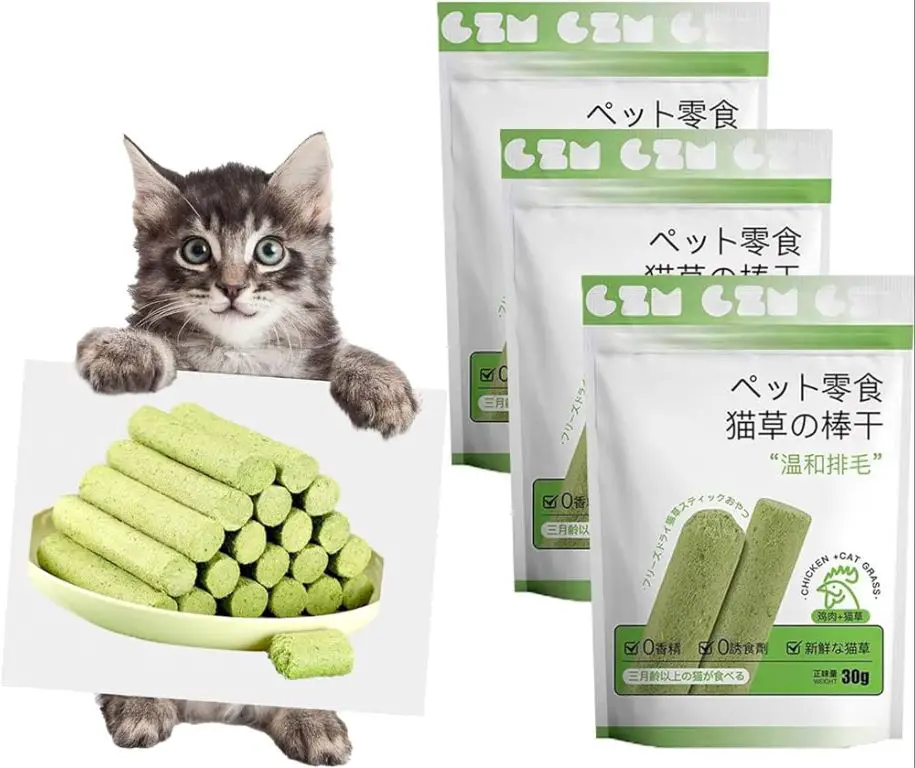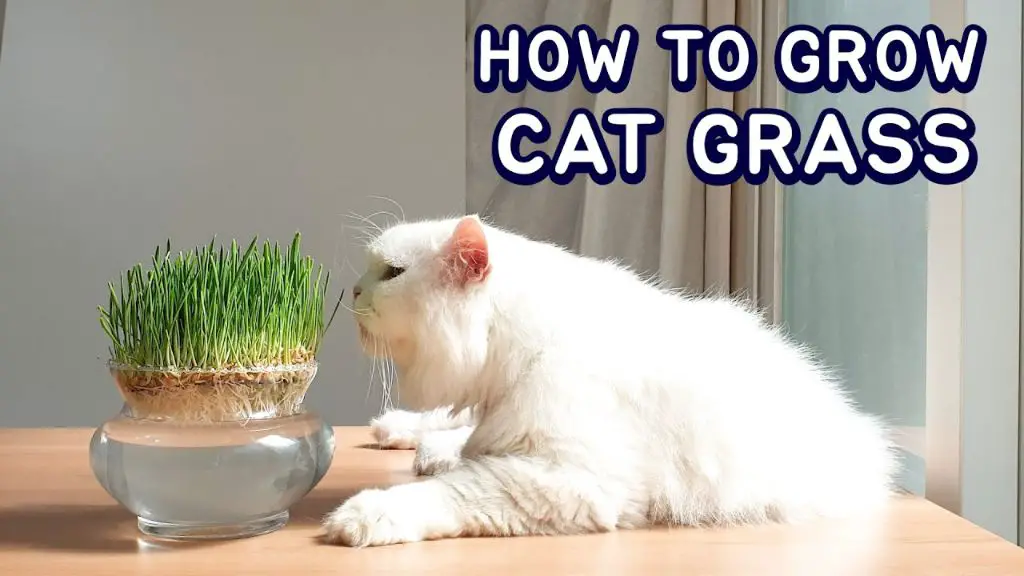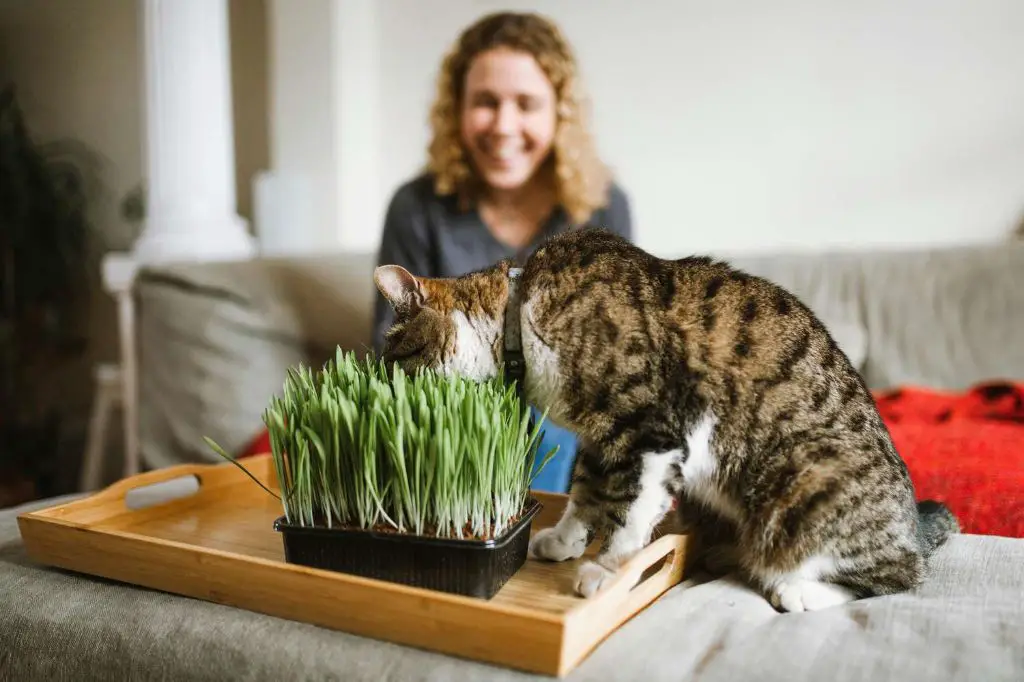What Are Cat Grass Sticks?
Cat grass sticks are a type of cat treat made from various edible grasses and herbs. They are a healthy, natural way to satisfy a cat’s instinctual craving to chew and nibble on greens. Cat grass sticks are commonly made from wheatgrass, oat grass, barley grass, and catnip (Source).
These beneficial plants are dried and compressed into thin, long sticks that a cat can chew on. The chlorophyll, vitamins, and minerals in cat grass are said to aid digestion and help prevent hairballs (Source). Cat grass sticks are low calorie, gluten-free, and contain no artificial colors or preservatives.
Cat grass sticks can be purchased at most pet supply stores, online retailers like Amazon and Chewy, or from specialty cat treat brands. Many cat owners also choose to easily grow trays of fresh cat grass at home for their feline friends to munch on.
Benefits of Cat Grass for Cats

One of the main benefits of cat grass for cats is that it aids digestion and acts as a natural laxative. Cat grass contains insoluble fiber that helps move food through the digestive tract and relieves constipation (How and Why to Grow Cat Grass for Your Kitty). The grass also provides vitamins, minerals and enzymes that support a cat’s gastrointestinal health (What is Cat Grass? | Hill’s Pet).
Another benefit is that cat grass satisfies a cat’s natural instinct to chew on plants and grass. In the wild, cats often chew on grasses to help with digestion and hairball control. Having cat grass available allows domestic cats to satisfy this innate behavior (Where the Green Grass Grows: Grass Treats for Cats | VCA). The fibrous nature of cat grass stems and leaves provides a texture that cats enjoy chewing on.
Overall, cat grass provides important fiber, nutrients, and enzymes to support feline digestive health. It also allows cats to satisfy their natural urge to chew on grasses and plants.
Potential Risks of Cat Grass
While cat grass can provide benefits, there are some potential risks to be aware of. One concern is pesticides and fertilizers that may be present on commercial cat grass products. According to VCA Hospitals, pesticides can cause toxicity if consumed in large amounts (source). For this reason, it’s best to grow your own cat grass or purchase pre-grown grass from a trusted organic source.
Another possible danger is mold or bacteria growth on the grass. If the grass starts to decay, it can harbor harmful organisms. Monitor your cat grass for any black, yellow, or white fuzz, which are signs of mold. Discard grass immediately if mold is present.
There is also a small risk of gastrointestinal obstruction or blockage if your cat eats too much grass. The fibrous nature of grass can be difficult to digest in large quantities. Monitor your cat’s grass intake and limit access if they start consuming excessive amounts.
Choosing Safe and Nutritious Cat Grass Sticks
When selecting cat grass sticks, it’s important to choose products that are organic and pesticide-free. Many mass-produced cat grass sticks contain chemicals and preservatives that can be harmful if ingested by cats.
Look for cat grass sticks made from 100% organic and natural ingredients. Reputable brands will clearly state if their products are organic, non-GMO, and free of pesticides or other chemicals.
It’s also best to choose fresh cat grass sticks instead of dried ones. Dried grass loses many of its nutritional benefits. Fresh grass sticks will be more palatable and appealing to cats. Check the manufacturing or expiration date and select the freshest option.
The ingredients list should be short and simple. Quality cat grass sticks contain wheatgrass as the main ingredient along with minimal additional binders or preservatives. Avoid products with artificial colors, flavors, or unnecessary fillers.
According to pet experts, the healthiest and safest cat grass sticks are organically grown and locally sourced. This ensures maximum freshness and no harmful pesticide residues.
How to Grow Your Own Cat Grass
Growing your own cat grass at home is easy and rewarding. The best seeds to use are wheatgrass, oat grass or barley grass. These provide the nutrients cats crave and are safe for them to consume.
Fill a shallow pot or tray with about 2 inches of potting soil. Sprinkle the seeds evenly across the top in a single layer. Gently press the seeds into the soil, then cover lightly with a thin layer of additional soil. Water thoroughly until the soil is moist.
Place the pot in a sunny spot or under a grow light. Keep the soil moist but not soaked. In just 5-10 days, you’ll begin to see sprouts. Once the grass reaches 3-4 inches tall, it’s ready for your cat to start nibbling.

To maintain a continuous supply, sow a new batch of seeds every 1-2 weeks. Trim off any yellow or dried grass as needed. Discard pots after 2-3 cuttings to prevent mold or bacterial buildup in the soil. Enjoy watching your cat relish the fresh, homegrown grass!
Cited source:
https://www.instructables.com/how-to-grow-cat-grass/
Serving Cat Grass Sticks
When serving cat grass sticks, it’s important not to overdo it. According to VCA Hospitals, treats like grass should make up no more than 10% of your cat’s total caloric intake[1]. This includes any other treats you may provide. A good rule of thumb is to limit grass intake to a few bites per day.
Monitor your cat’s consumption, especially when first introducing grass sticks. Eating too much too fast may cause vomiting or diarrhea. Adjust amounts based on your individual cat’s tolerance. Store any unfinished sticks in an airtight container in the refrigerator for up to 5-7 days.
Grass that is wilted or has been left out too long can grow mold and bacteria. Always inspect sticks before serving and discard any that look spoiled. Rotating through fresh sticks will provide the best nutrition and safety.
Signs Your Cat Enjoys Eating Grass
There are a few telltale signs that your cat enjoys and benefits from eating grass. According to veterinarian Dr. Gary Richter, some indicators your cat seeks out grass as a normal part of their diet include:
Increased chewing/licking – If you notice your cat spending more time grazing and chewing on grass, it’s likely providing benefits. Cats that enjoy the taste and sensation of grass will chew it thoroughly.

Seeking out grass – A cat that seeks out patches of grass or houseplants and deliberately eats them is showing a natural urge for greens. This is different from random nibbling. Look for directed grass eating behavior.
Improved hairballs – One major benefit of grass is it provides fiber and aids digestion. If your cat has fewer vomiting episodes and improved hairball control when eating grass regularly, that’s a clue they benefit from the added roughage.
Cats That Should Avoid Grass
While eating grass is normal for many cats, certain groups should avoid it or only have limited amounts. This includes kittens, pregnant/nursing cats, and cats with certain illnesses.
Kittens have immature digestive systems, so grass can upset their stomachs more easily than adult cats. The fibrous nature of grass is also hard for their small bodies to break down and pass. It’s best to limit grass intake for kittens under 6 months old.
Pregnant and nursing mother cats also have increased nutritional needs and sensitive digestive systems. Large amounts of grass can interfere with their ability to get adequate nutrition for themselves and their kittens. It’s best to monitor their grass intake and avoid large quantities.
Cats with illnesses like diabetes, hyperthyroidism, kidney disease, or gastrointestinal issues are prone to vomiting and upset stomachs. The extra fiber from grass may irritate their condition. Check with your vet before offering grass to cats with health problems.
While most cats can safely nibble on grass, moderation is key. Pay extra attention to grass intake for vulnerable cats like kittens, pregnant/nursing cats, and those with health issues.
Alternatives to Cat Grass Sticks
For cats that cannot eat regular cat grass for health reasons or owners who want more variety, there are several alternatives that can fulfill the same needs.
Other edible greens like wheatgrass, oat grass and barley grass can provide similar nutrition and fiber as cat grass (Source 1). These can be grown at home or purchased as supplements. Just be sure any store-bought greens are organic and chemical free (Source 2).
Catnip is another popular alternative that many cats enjoy chewing and eating. The plant has a minty aroma cats find stimulating. Catnip can be grown fresh or purchased dried. However, some cats may lose interest in catnip after continued exposure.

Chew toys made of vegetable matter like corn husks can also give cats an outlet for their natural chewing instinct. Edible chew sticks and logs made from natural ingredients are a tasty, safe option. Just supervise your cat to prevent digestive issues from eating any fabric or toy parts.
With so many alternatives available, cat owners can find the right natural plant supplements or chews to satisfy a cat’s grass craving, even if regular grass is off limits.
The Bottom Line
Cat grass sticks have many potential benefits but also some risks to consider. The grass can help satisfy cats’ natural urge to chew and eat plants, provide fiber, and aid digestion ([1]). However, some cats may be sensitive to certain grasses or consume them excessively, leading to vomiting or diarrhea ([2]).
When used occasionally under supervision, cat grass sticks are likely safe for most cats. Opt for organic, pesticide-free options to reduce risks. Cats with gastrointestinal issues or that overeat grass may need to avoid it. Consider alternatives like catnip or silver vine sticks. Grass sticks can enrich cats’ environments but require monitoring for safety.
